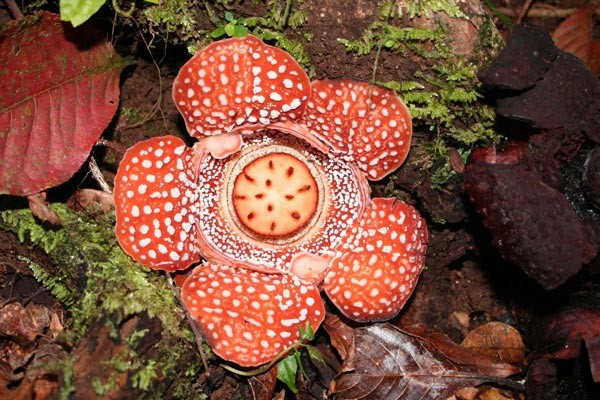两项研究颠覆植物学教条:两种与众不同的植物抛弃叶绿体
近日,两项新的研究给植物群落带来了不小的冲击:研究人员发现了两种与众不同的植物,它们抛弃了让叶绿体工作的遗传机能。这两项研究分别发表于《molecular Biology and Evolution》和《Plant Physiology》杂志上。

两类植物丢弃叶绿体。图片来源:Dr. Julie Barcelona
叶绿体让植物变得非常特别。它们给植物穿上绿色的“外衣”、帮助它们把太阳能转化为糖分,并且执行着各种各样的重要化学过程。叶绿体甚至还拥有自己的DNA。
而近日发表的两项新研究给植物群落带来了不小的冲击:研究人员发现了两种与众不同的植物,它们抛弃了让叶绿体工作的遗传机能。
其中一个是Rafflesia lagascae (如图所示),因为气味难闻,有时这种植物也被称为尸花。它是一种寄生植物,靠葡萄藤样的热带藤本植物生存。而这种植物已经完全丧失了叶绿体基因组,研究人员在近日出版的《分子生物学和进化》期刊上发表了相关结论。
第二种植物是4种Polytomella藻类,它们也缺失了这种DNA。Polytomella 是一种独立生活的单细胞植物,它们从生活的淡水中摄取食物。就像尸花一样,这种藻类仍然有叶绿体的外壳,一种名为质粒体的物质,但是没有叶绿素让它们呈现绿色。而质粒体仍然有自己的DNA。
但是,对该藻类4个物种的加强dna测序并未发现任何质粒体,而且这些藻类的主要基因组中也没有维持质粒体基因组平稳运行所需要的基因。研究人员测序尸花的全基因组时也发现了同样的事情。该研究小组确实发现了叶绿体基因的残余物,但是那些基因片段属于其寄生的藤本植物所有。
这两个研究小组表示,一旦叶绿体丧失主要功能,质粒体基因将逐渐衰弱,或者移动到主要基因或另一个细胞组分(线粒体)的基因中,这使得质粒体基因不再必要。
原文摘要:
Possible loss of the chloroplast genome in the parasitic flowering plant Rafflesia lagascae(Rafflesiaceae)
Jeanmaire Molina, Khaled M. Hazzouri, Daniel Nickrent,Matthew Geisler, Rachel S. Meyer, Melissa M. Pentony,Jonathan M. Flowers, Pieter Pelser, Julie Barcelona,Samuel Alan Inovejas, Iris Uy, Wei Yuan, Olivia Wilkins,Claire-Iphanise Michel, Selina LockLear, Gisela P. Concepcion andMichael D. Purugganan
Rafflesia is a genus of holoparasitic plants endemic to Southeast Asia that has lost the ability to undertake photosynthesis. With short-read sequencing technology, we assembled a draft sequence of the mitochondrial genome of Rafflesia lagascae Blanco, a species endemic to the Philippine island of Luzon, with ∼350x sequencing depth coverage. Using multiple approaches, however, we were only able to identify small fragments of plastid sequences at low coverage depth (< 2x) and could not recover any substantial portion of a chloroplast genome. The gene fragments we identified included photosynthesis and energy production genes (atp, ndh, pet, psa, psb, rbcL), ribosomal RNA genes (rrn16, rrn23), ribosomal protein genes (rps7, rps11, rps16), transfer RNA genes, as well as matK, accD, ycf2, and multiple non-genic regions from the inverted repeats. None of the identified plastid gene sequences had intact reading frames. Phylogenetic analysis suggests that ~33% of these remnant plastid genes may have been horizontally transferred from the host plant genusTetrastigma with the rest having ambiguous phylogenetic positions (<50% bootstrap support), except for psaB which was strongly allied with the plastid homologue in Nicotiana. Our inability to identify substantial plastid genome sequences from R. lagascae using multiple approaches - despite success in identifying and developing a draft assembly of the much larger mitochondrial genome - suggests that the parasitic plant genus Rafflesiamay be the first plant group for which there is no recognizable plastid genome, or if present is found in cryptic form at very low levels.
A plastid without a genome: evidence from the nonphotosynthetic green alga Polytomella
David Roy Smith and Robert W Lee
Polytomella is a free-living, nonphotosynthetic green alga, closely related to the model organism Chlamydomonas reinhardtii. Although colorless, Polytomella has a plastid, but it is still unknown whether it harbors a plastid genome. We took a next-generation sequencing approach, along with transcriptome sequencing, to search for a plastid genome and an associated gene expression system in Polytomella. Illumina sequencing of total DNA from four Polytomella species did not produce any recognizable plastid-derived reads, but did generate a large number of mitochondrial DNA sequences. Transcriptomic analysis of Polytomella parva uncovered hundreds of putative nuclear-encoded, plastid-targeted proteins, which support the presence of plastid-based metabolic functions, similar to those observed in the plastids of other nonphotosynthetic algae. Conspicuously absent, however, were any plastid-targeted proteins involved in the expression, replication, or repair of plastid DNA. Based on these and earlier findings, we argue that Polytomella represents the first well-supported example of a primary-plastid-bearing lineage without a plastid genome.
标签: 叶绿体 尸花 质粒体基因
作者:唐凤 点击:次

